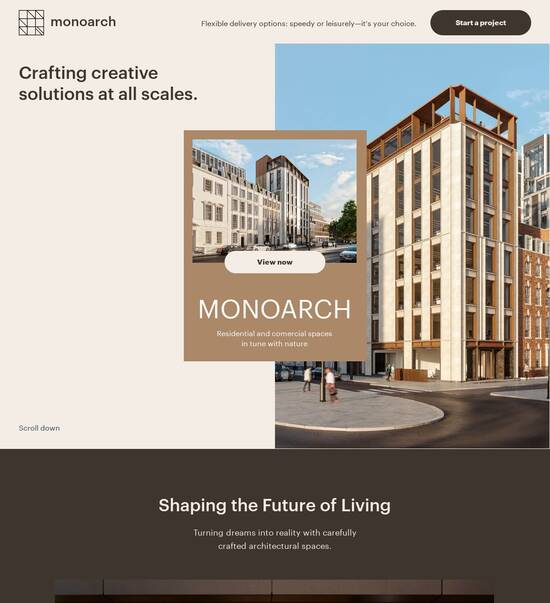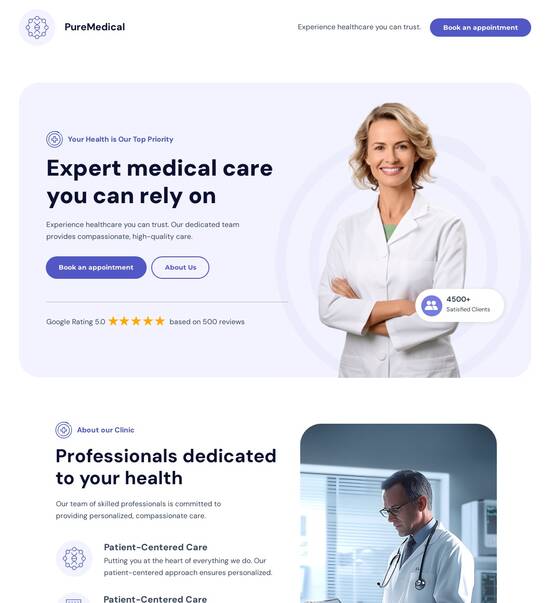
One Page Website Template for Social Workers
Explore Similar TemplatesAbout template
Create a professional one-page website for social workers with ease using Instapage's customizable templates. Showcase your services, highlight testimonials, and drive conversions to grow your client base.
Recommended templates

Easy to build without coding
With the intuitive drag-and-drop builder, anyone on your team can create high-converting pages without any knowledge of code or design. Make enhancements to your landing page with custom widgets using Javascript, HTML/CSS, or third-party scripts.

Multiple layouts for any industry and goal
Select from 500+ landing page layouts built to boost conversions across industry-specific scenarios. Customize them by adjusting fonts, adding images, and generating on-brand content with the AI assistant. Quickly scale with Instablocks® and Global Blocks that you can save, reuse, and update globally.

Loads fast and looks polished on any device
Every template is responsive, which means they present professionally on any device and load blazingly fast with our Thor Render Engine. You can also power them up with Google AMP technology to deliver an unparalleled mobile experience and drive higher conversions.

Robust analytics & experimentation
Get real-time updates and reporting across all your devices, showing the number of visitors, conversions, cost-per-visitor, and cost-per-lead. Launch AI-powered experiments, run A/B tests, and use heatmaps to analyze user behavior, then optimize your landing page to maximize conversions.







Easy to build without coding
With the intuitive drag-and-drop builder, anyone on your team can create high-converting pages without any knowledge of code or design. Make enhancements to your landing page with custom widgets using Javascript, HTML/CSS, or third-party scripts.
Multiple layouts for any industry and goal
Select from 500+ landing page layouts built to boost conversions across industry-specific scenarios. Customize them by adjusting fonts, adding images, and generating on-brand content with the AI assistant. Quickly scale with Instablocks® and Global Blocks that you can save, reuse, and update globally.
Loads fast and looks polished on any device
Every template is responsive, which means they present professionally on any device and load blazingly fast with our Thor Render Engine.
Robust analytics & experimentation
Get real-time updates and reporting across all your devices, showing the number of visitors, conversions, cost-per-visitor, and cost-per-lead. Launch AI-powered experiments, run A/B tests, and use heatmaps to analyze user behavior, then optimize your landing page to maximize conversions.
All the features you need to build lead-generating landing pages
Explore more featuresLearn how to build top-performing landing pages for any goal
FAQs
Leading the way in building high-performing landing pages





Step-by-step guide to using Instapage for effective landing page optimization
Creating a landing page that converts effectively is crucial for digital marketing success. Instapage's powerful tools empower marketers to build and optimize landing pages efficiently without needing extensive design or coding skills. This guide will walk you through the steps on how to maximize your landing page ROI using Instapage.
Understanding Instapage's features
Instapage provides various functions that simplify landing page creation for your campaigns. From flexible templates to optimization tools, the platform ensures that both novice and experienced marketers can create effective landing pages that resonate with their target audience.
- 100+ customizable templates: Select from a library of high-converting templates tailored to different industries, including business services and education.
- Built-in optimization tools: Utilize A/B testing and detailed analytics to continuously improve page performance.
- Collaboration features: Work seamlessly with team members by providing feedback and making real-time edits on landing pages.
Setting up your first landing page
Creating your first landing page with Instapage is straightforward. Start by selecting a template that aligns with your campaign objectives. Once you've chosen a template, follow these steps:
- Customize your layout: Use the drag-and-drop builder to modify sections, add images, and insert lead generation elements.
- Add targeted messaging: Ensure your content speaks directly to your audience's needs by using personalized text.
- Integrate lead capture forms: Incorporate engaging forms to capture visitor information effectively.
Optimizing for conversions
After setting up your landing page, it's crucial to focus on optimizations that can improve conversion rates. Consider implementing the following tactics:
- Conduct A/B testing: Test different headlines and layouts to determine what resonates best with your audience.
- Utilize heatmaps: Analyze user behavior on your page to identify areas that need adjustments or enhancements.
- Implement personalized content: Use dynamic text replacement to tailor content based on user demographics for better engagement.
After you've optimized your landing page, monitoring its performance will help you understand its effectiveness and areas for improvement.
In conclusion, leveraging Instapage's robust features allows marketers to create, optimize, and personalize landing pages that drive results. Implement these steps to ensure you're maximizing your digital marketing efforts.
Ready to transform your digital campaigns? Start your free trial with Instapage today and see the difference in your conversion rates!
Understanding the one page website template for social workers: transforming digital presence
The role of one page websites in social work
One page websites have become a crucial asset for social workers seeking to enhance their digital presence. In a field where outreach and engagement are paramount, these streamlined platforms enable professionals to present pertinent information in a clear and concise manner. By utilizing a one page website, social workers can easily showcase their services, share relevant resources, and connect with potential clients more effectively.
Moreover, having a dedicated online space fosters trust within the community. It provides a platform to highlight credentials, areas of expertise, and client testimonials, which can significantly help in client acquisition. The digital persona created through a one page website can increase visibility and outreach, making it easier for individuals in need to seek help.
The importance of digital representation for social workers
Digital representation is no longer optional for social workers; it’s a necessity. Potential clients often search online for services, and an engaging one page website serves as a critical first impression. It can convey professionalism and accessibility, inviting users to learn more about the services offered. Additionally, in a world where social media and digital communications dominate, maintaining an online presence can enhance professional networking and collaboration.
The power of simplicity in web design
A one page layout boasts numerous advantages, primarily through its simplicity and ease of navigation. Users appreciate the straightforward structure where all essential content is available at a glance without complicated menus or links. This design reduces the chances of visitors leaving the site out of frustration or confusion, thereby increasing the likelihood of further engagement.
Enhanced user experience by reducing load time and distractions.
Focused content delivery ensures that visitors find what they need efficiently.
Mobile-friendly design, crucial for users accessing information on the go.
Key features of the one page website template
To effectively craft one page websites, certain features are indispensable. Understanding HTML fundamentals is vital for social workers who wish to create an engaging digital experience. HTML provides the framework to structure content, ensuring it is not only visually appealing but also user-friendly. As technology advances, integrating artificial intelligence can enhance these templates by offering suggestions for layout adjustments based on user behavior.
Another essential feature is the incorporation of dynamic contact forms. These forms facilitate user engagement, allowing clients to reach out effortlessly. A well-designed contact form should include form fields that collect necessary information, such as name, email, and message. Additional fields for appointment scheduling or service inquiries can further enhance interaction. These features increase the likelihood of follow-ups and foster a proactive relationship between the social worker and potential clients.
Showcase your work: creating a portfolio section
Having a robust portfolio section on a one page website is vital for displaying previous projects and successes. Visual storytelling can significantly impact how potential clients perceive the effectiveness of a social worker's practices. High-quality images paired with compelling descriptions can create a more profound connection to the service provider’s work. Best practices for this section include using clear headings, maintaining a consistent style, and focusing on the most impactful narratives.
Organizing projects by theme or demographic to showcase versatility.
Utilizing a grid layout for easy visual scanning.
Incorporating client testimonials alongside project descriptions.
Enhancing user engagement and interaction
User engagement can be significantly bolstered through a well-planned blog section. Regular blogging gives voice to social workers, allowing them to share insights, experiences, and expertise while contributing to important discussions in social work. Topics that may resonate with readers include mental health tips, community resources, advocacy efforts, or personal stories that provide context to their work.
Blogging also serves as a tool for search engine optimization, driving more traffic to the site as topics are shared across platforms. This continuous interaction not only helps in building community but also acts as a repository of knowledge—a valuable asset for both social workers and their clients.
Integrating chat support features for real-time interaction
Integrating chat support can be transformative for social workers’ one page websites. Many individuals seeking assistance can feel anxious or uneasy about reaching out; chat features provide a low-pressure opportunity to ask questions. Technical solutions such as third-party chat applications can be easily integrated. This allows for real-time feedback and helps cater responses at any time of day, addressing the immediate needs of users.
Enhancing user experience by providing quick answers.
Reducing barriers to communication for prospective clients.
Building rapport that may lead to long-term relationships.
Social media integration and outreach
A successful one page website for social workers must seamlessly integrate social media platforms. By showcasing links to Facebook, Twitter, LinkedIn, and Instagram, social workers can enhance their outreach. This integration creates a holistic digital presence, allowing visitors to explore various facets of the service provider's work. Strategies should include visually appealing social media buttons and consistent branding across all platforms.
In addition to linking social profiles, social media sharing options on the website enable users to share content easily. This function can significantly expand the reach of blog posts, resources, or upcoming events, encouraging advocates in the local community to participate, share, and engage with the content.
Utilizing hashtags to increase visibility across platforms.
Creating shareable infographics that visually convey key information.
Encouraging client testimonials and success stories to be shared.
Customization and flexibility: making the template your own
Customization plays a vital role in ensuring that the one page template reflects the identity and mission of the social worker. Users should have the flexibility to choose design elements such as color schemes, fonts, and layouts that resonate with their professional branding. By allowing for personalization, social workers can foster a stronger connection with their audience, conveying authenticity and commitment.
A well-thought-out customizable template offers options for fonts that ensure readability and colors that extend their branding. When potential clients see consistent branding across platforms, it instills confidence and trust, directly impacting their willingness to seek services. Furthermore, a one page website should provide mobile optimization to ensure that potential clients can interact with the site no matter where they are.
Choosing from a selection of color palettes to match branding.
Integrating adaptive design elements that enhance accessibility.
Incorporating user-friendly interface changes based on feedback.
Leveraging data and analytics for continuous improvement
Monitoring user interactions and engagement metrics is crucial for ongoing success. By utilizing analytics tools integrated into the website, social workers can gain insights into visitor behavior, such as user visits, duration on site, and form submission rates. Understanding these metrics can help identify trends and improve content selection and placement.
This data can inform adjustments in outreach strategies, aiding social workers in refining their approach to better meet the needs of their audience. The more a social worker understands their visitors, the more they can fine-tune messaging and expand reach effectively.
Adapting content based on user interests
Content adaptation based on user interest allows social workers to create more tailored resources that engage their target demographics. By analyzing data, it becomes possible to pivot focus towards topics that resonate more significantly with users, driving not just traffic but meaningful connection. Such proactive adjustments signal to visitors that their needs are recognized and prioritized, enhancing overall user experience.
Conducting surveys to gather direct feedback from users.
Analyzing bounce rates and page views to determine effective content.
Regularly updating content to stay relevant to current trends in social work.
Practical applications and case studies
Exploring successful examples of social workers who have adopted one page websites illustrates their impact. Many professionals have transformed their outreach through concise and engaging online platforms. For instance, one family therapist utilized a simple website to present services and share client testimonials, leading to a noticeable increase in client inquiries. Such practical applications reveal how impactful a well-constructed digital space can be.
Another case study highlighted a social worker focused on youth advocacy who used a one page website to consolidate resources for parents, leading to enhanced community engagement and increased support. These inspiring stories reflect how leveraging a one page design can effectively communicate purpose while garnering trust and interest.
Lessons learned from diverse social work projects
The journey through various social work projects reveals important lessons about showcasing work effectively. Achieving clarity in messaging cultivates connection; thus, each project should focus on telling a cohesive story. Social workers have learned to avoid overwhelming potential clients with excessive information by maintaining brevity without sacrificing essential details.
Prioritizing quality over quantity when showcasing projects.
Utilizing storytelling techniques to engage users emotionally.
Soliciting feedback from peers to improve website effectiveness.
Future trends in one page website development for social workers
As technology continues to evolve, so will the tools available for social workers to enhance their digital presence. Future trends may include improved artificial intelligence that can offer insights for website optimization or automated chat functionalities that are even more intuitive. Staying ahead of these technological advancements will empower social workers to continually refine their outreach strategies.
Similarly, the emphasis on user experience will likely dictate the design and functionality of one page websites moving forward. As users become increasingly discerning, social workers will need to prioritize not just appearance but effectiveness in ensuring the site meets client needs.
The importance of continuous learning and adaptation
Continuous learning will play a substantial role in the longevity of social workers' digital strategies. Understanding and adapting to new tools, mediums, and practices ensures sustained engagement. Webinars, online courses, and peer networking can provide vital resources for professional growth.
Engaging in regular professional development opportunities.
Collaborating with tech experts to stay updated on trends.
Participating in communities that discuss digital marketing strategies.
Ready to skyrocket conversions?
Supercharge your ad campaigns with high-performing landing pages
Get started














